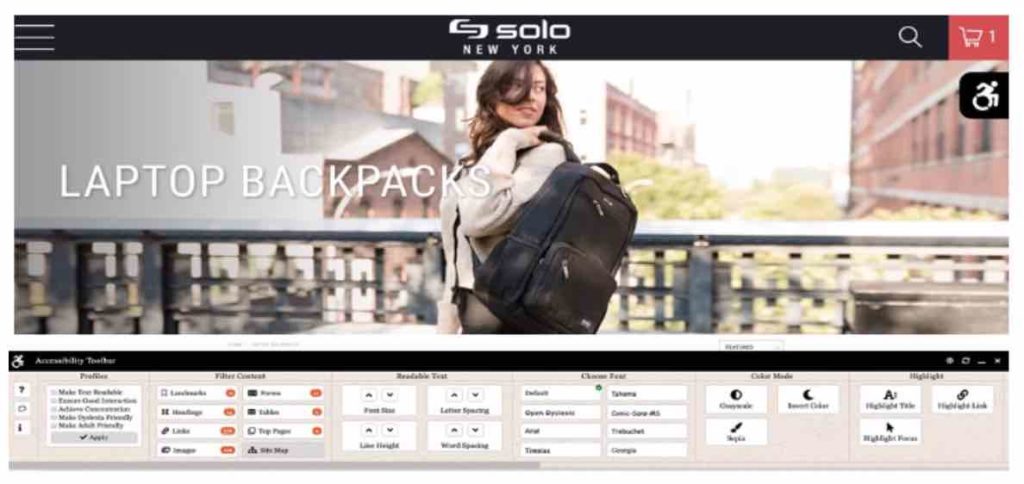How Accessibility is Breaking New Digital Ground
Editor’s Note: This guest post was generously contributed by Christi Olson, head of evangelism for search and advertising at Microsoft. If you missed Christi speaking on the topic at May’s Digital Summit at Home, you’re in luck: Christi and 20+ other content and digital marketing experts will be speaking July 14-16 at the next Digital Summit at Home. This three-day, fully interactive online event delivers all of the awesome learning and networking opportunities from Digital Summit’s in-person events to your living room, office or wherever you choose to join. Register today!
The internet is widely considered one of the greatest inventions of all time. Like the wheel and light bulb, the internet has become an invisible backdrop in our lives, growing increasingly important by the day. From Baby Boomers (68% now own a smartphone – up from 25% in 2011) to seniors (42% now own a smartphone – up from 18% in 2013), everyone is experiencing the impact.
The change has been so quick and powerful that younger generations don’t even feel it. Today’s young people are considered digital natives – 100% of 18- to 29-year-olds in the U.S. use the internet, and 9 out of 10 millennials own a smartphone. This makes the internet a permanent fixture for future generations to come as a key source of news, entertainment, shopping and more. Of course, this affects everyone’s future, and is creating a heightened urgency around the topics of accessibility, inclusion and diversity. If ever there was a time to put protective standards in place, now is it.
According to the World Health Organization (WHO) report, it is estimated that 15% percent of the world’s population are living with some form of disability including blindness and vision impairment, deafness and hearing loss, learning disabilities, cognitive limitations, photosensitivity, limited movement, etc. The internet presents unique opportunities to help empower over 1 billion disabled people. For instance, screen readers are helping to change lives, enabling those with no or low vision to surf the web.
But accessibility is really about creating a better user experience for all. It’s about inclusive, thoughtful design that emphasizes things like color contrasting, content structure for readability, more descriptive URLs and better image tagging. At the end of the day, everyone benefits from lower barriers, increased access and higher ease of use.
The Americans with Disabilities Act (ADA) requires that all businesses must comply with accessible design standards and remove barriers. Originally created for physical spaces, this now extends to websites as the digital and physical worlds collide, stirring up some important questions:
What are the best practices for inclusive web design?
How can businesses ensure that their websites are compliant with the latest regulations?
Are there any tools to help with accessibility testing?
Getting answers requires three groups – tech builders, lawmakers and businesses. These key groups are making accessibility a priority as they come together to put inclusive design standards in place. Here’s how each group is approaching digital accessibility:
Tech Builders
Tech builders are building tools that promote accessibility through the lens of technology. They are building at a breathtaking pace – for example, Wikipedia lists over 25 screen readers available and counting. These tools convert websites into speech (or Braille), enabling users to hear content and navigate the web with their keyboard. Microsoft’s Seeing AI app goes even further, narrating the world around us – everything from books to menus to street signs and even facial expressions are converted into speech.
There are also numerous tools available for accessibility testing such as Accessibility Insights. These tools help designers spot accessibility failures – common issues include color contrast ratios, button vs text contrasts and readability structures.
Lawmakers
Lawmakers are also working to promote accessibility through the lens of the law. The Americans with Disability Act (ADA) became law in 1990 providing civil rights protections to prohibit discrimination against individuals with disabilities. In 2008 an Amendment was signed into law that changed the definition of disability and in 2010 the ADA released standards for accessible design.
Judges are increasingly finding non-compliance as discriminatory – 2018 saw 2,285 ADA website lawsuits filed in federal courts across the United States, an increase of 181% than in the previous year. In fact, a recent, high profile case with Domino’s Pizza made it all the way to the Supreme Court. The Supreme Court denied the petition hearing, leaving in place a ruling against Domino’s in the lower courts, meaning other restaurants and retailers could end up in similar allegations. Domino’s now faces a very laborious and expensive retrofitting project. it’s highly recommended that businesses approach all future web development projects with an accessibility-first design.
Below is a list of inclusive design best practices as a starting point. For more detailed guidelines, refer to the official Website Content Accessibility Guidelines (WCAG).
- The site and all sections of the site are keyboard accessible
- The site is free of keyboard trap. The keyboard focus is never trapped in a loop that cannot be escaped.
- The site never loses focus and is always visible when moving through the page with the keyboard.
- The tab order has a logical flow and structure.
- Headings are nested properly and are nested in a logical way.
- Links are unambiguous, unique and contextual and can be understood when seen as a standalone element, i.e “Learn more about Microsoft’s Inclusive Design Principles” vs “Click here.”
- All relevant images are described using an <alt> text.
- All multimedia content and videos are appropriated described in <alt> text and has appropriate captioning and audio description.
- All form inputs have explicit labels and the instructions are associated with inputs.
- Tables are coded properly and have proper headers and column attributes.
- Frames are named and all frames have a name element.
- Flashing elements are compliant and elements that do flash on screen do so at a rate of less than 3Hz.
- Text has sufficient color contrast ratio of 4.5:1 with the background.
- Site doesn’t timeout unexpectedly. Identify elements that may “timeout” and verify that the user can request more time.
- CSS is not required to use the page and the page makes sense with or without CSS.
- Page titles are descriptive
Today businesses can use tools FastPass from AccessibilityInsights.io to start finding the most common and high impact accessibility issues on their sites. It assesses websites for compliance against the WCAG 2.1 AA recommendations.
Businesses
Today’s businesses are adopting a new Return on Purpose (ROP) mindset with an increased focus on purpose beyond profit. This includes sustainable products, inclusive and diverse marketing and accessible-first web design. They are exploring creative ways to enhance the customer experience to include everyone.
For example, Solo – maker of laptop backpacks – has created a handicap icon in the upper right corner of their website which opens an accessibility toolbar along the bottom of the site. Users can then adjust settings such as filters, colors, greyscales and a dyslexia friendly font.

As businesses embrace accessibility, they embark on a journey, not a destination. The digital landscape thrives on change and disruption. If we know anything, it’s that the technology of tomorrow will look different from the technology of today. What matters most on accessibility is that we keep the needle moving in the right direction and ensure our new digital world reflects the human values of the real world.


